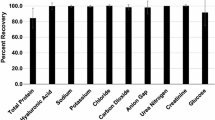Abstract
Objective
To determine, during normal pregnancy, maternal serum (MS) and anniotic fluid (AF) concentrations of soluble Fas (sFas), an apoptosis-suppressing molecule that might play a role in the apoptotic process. Soluble Fas levels might explain existing immunotolerance, fetal well being, and rupture of membranes at term.
Methods
Sixty-six healthy, nonsmoking, pregnant women (mean age 32.6 ± 4.8 years) with uncomplicated singleton pregnancies (15 in the first trimester, 30 in the second trimeste, and 21 at term vaginal delivery) and 20 healthy nonpregnant women (mean age 32.5 ± 3.8 years) were included in the study. MS and AF sFas concentrations were measured by a sandwich enzyme-linked immunosorbent assay, and parametric tests were used in the statistical analysis.
Results
MS and AF sFas concentrations significantly depended on gestational age (P < .0008 and P < .0002, respectively). MS concentratiosn were significantly lower in the first trimester than those in the second trimester (P < .003), those at term (P < .03), and those in nonpregnant controls (P <.005). AF concentrations decreased significantly at term compared with those in the second trimester (P < .0003). AF sFas concentrations in the second trimester and at term were significantly lower than respective MS concentrations (P < .00001).
Conclusions
MS sFas concentrations decreased significantly in the first trimester of pregnancy, possibly affecting semiallograft tolerance. In the second trimester, concentrations return to control levels and remain unchanged until delivery. AF sFas concentrations decrease at term compared with the second trimester, possibly indicating increased apoptosis in preparation for rupture of membranes.
Similar content being viewed by others
References
Reinhard G, Noll A, Schlebusch H, Malimann P, Ruecker AV. Shifts in the TH1/TH2 balance during human pregnancy correlate with apoptosis changes. Biochem Biophys Res Commun 1998;245:933–938.
Nagata S, Golstein P. The Fas death factor. Science 1995;267:1449–1456.
Trauth BC, Klas C, Peters AM, et al. Monoclonal antibodymediated tumor regression by induction of apoptosis. Science 1989;245:301–305.
Bellgrau D, Gold D, Selawry H. A role for CD 95 ligand in preventing graft rejection. Nature 1995;377:630–632.
Griffith T, Brunner T, Fletscher S, et al. Fas ligand-induced apoptosis as a mechanism of immune privilege. Science 1995;270:1189–1192.
Hoshimoto K, Hayashi M, Ohkura T. Plasma levels of soluble Fas during normal pregnancy. Gynecol Obstet Invest 2001;51:96–98.
Tanaka M, Suda T, Haze K, et al. Fas ligand in human serum. Nat Med 1996;2:317–322.
Cheng J, Zhou T, Liu C, et al. Orotection of Fas-mediated apoptosis by a soluble form of the Fas molecule. Science 1994;263:1759–1762.
Papoff G, Cascino I, Eramo A, Starace G, Lynch DH, Ruberti G. An N-terminal domain shared by fas/Apo-1 (CD 95) soluble variants prevents cell death in vitro. J Immunol 1996;156:4622–4630.
Judo S, Kobayashi S, Kayagaki N, et al. Serum levels of soluble Fas/APO-1 (CD 95) and its molecular structure in patients with systemic lupus erythematosus (SLE) and other autoimmune diseases. Clin Exp Immunol 1997;107:89–95.
Hasunuma T, Kayagaki N, Asahara H, et al. Accumulation of soluble Fas in inflamed joints of patients with rheumatoid arthritis. Arthritis Rheum 1997;40:80–86.
Jacobson MD, Weil M, Raff MC. Programmed cell death in animal development. Cell 1997;88:347–354.
Narayanan V. Apoptosis in development and disease of the nervous system. 1. Naturally occurring cell death in the developing nervous system. Pediatr Neurol 1997;16:9–13.
Lee DM, Osathanondh R, Yeh J. Localization of Bcl-2 in the human fetal mullerian tract. Fertil Steril 1998;70:135–140.
Brill A, Torchinski A, Carp H, Toder V. The role of apoptosis in normal and abnormal embryonic development. J Assist Reprod Genet 1999;16:512–519.
Runie R, Lockwood CJ, LaChapelle L, et al. Apoptosis and Fas expression in human fetal membranes. J Clin Endocrinol Metab 1998;83:660–666.
Malamitsi-Puchner A, Sarandakou A, Tziotis J, Trikka P, Creatsas G. Evidence for a suppression of apoptosis in early postnatal life. Acta Obstet Gynaecol Scand 2001;80:994–997.
Lin H, Mosmann TR, Guilbert L, Tuntipopipat S, Wegmann TG. Synthesis of T-helper 2-type cytokines at the maternal-fetal interface. J Immunol 1993;151:4562–4573.
Hill JA, Polgar K, Anderson DJ. T-helper 1-type immunity to trophoblast in women with recurrent spontaneous abortion. JAMA 1995;273:1933–1936.
Clark AG, Kendall MD. The thymus in pregnancy: The interplay of neural, endocrine and immune influences. Immunol Today 1994;15:545–551.
Medina KL, Smithson G, Kineade PW. Suppression of B lymphopoeisis during normal pregnancy. J Exp Med 1993;178:1507–1515.
Athanassakis I, Bleackley RC, Paetkau V, Guilbert L, Barr PJ, Wegmann TG. The immunostimulatory effect of T cells and T cell lymphokines on murine fetally derived placental cell. J Immunol 1987;138:37–44.
Smith SC, Baker PN, Symonds EM. Increased placental apoptosis in intrauterine growth restriction. Am J Obstet Gynecol 1997;177:1395–1401.
Moley KH, Chi MM, Knudson CM, Korsmeyer SJ, Mueckler MM. Hyperglycaemia induces apoptosis in pre-implantation embryos through cell death effector pathways. Nat Med 1998;4:1421–1424.
Forsberg H, Erikson UJ, Welsh N. Apoptosis in embryos of diabetic rats. Pharmacol Toxicol 1998;83:104–111.
Fortunato SJ, Ramkumar M, Bryant C, Lombardi SJ. Programmed cell death (apoptosis) as a possible pathway to metalloproteinase activation and fetal emmbrane degradation in premature rupture of membranes. Am J Obstet Gynecol 2000;182:1468–1476.
Seishima M, Takemura M, Saito K, et al. Highly sensitive ELISA for soluble Fas in serum. Increased soluble Fas in the elderly. Clin Chem 1996;42:1911–1914.
Author information
Authors and Affiliations
Corresponding author
Rights and permissions
About this article
Cite this article
Malamitsi-Puchner, A., Sarandakou, A., Papagianni, V. et al. Concentrations of Soluble Fas in Maternal Serum and Amniotic Fluid During Uncomplicated Pregnancies. Reprod. Sci. 10, 158–160 (2003). https://doi.org/10.1016/S1071-5576(03)00002-9
Published:
Issue Date:
DOI: https://doi.org/10.1016/S1071-5576(03)00002-9




